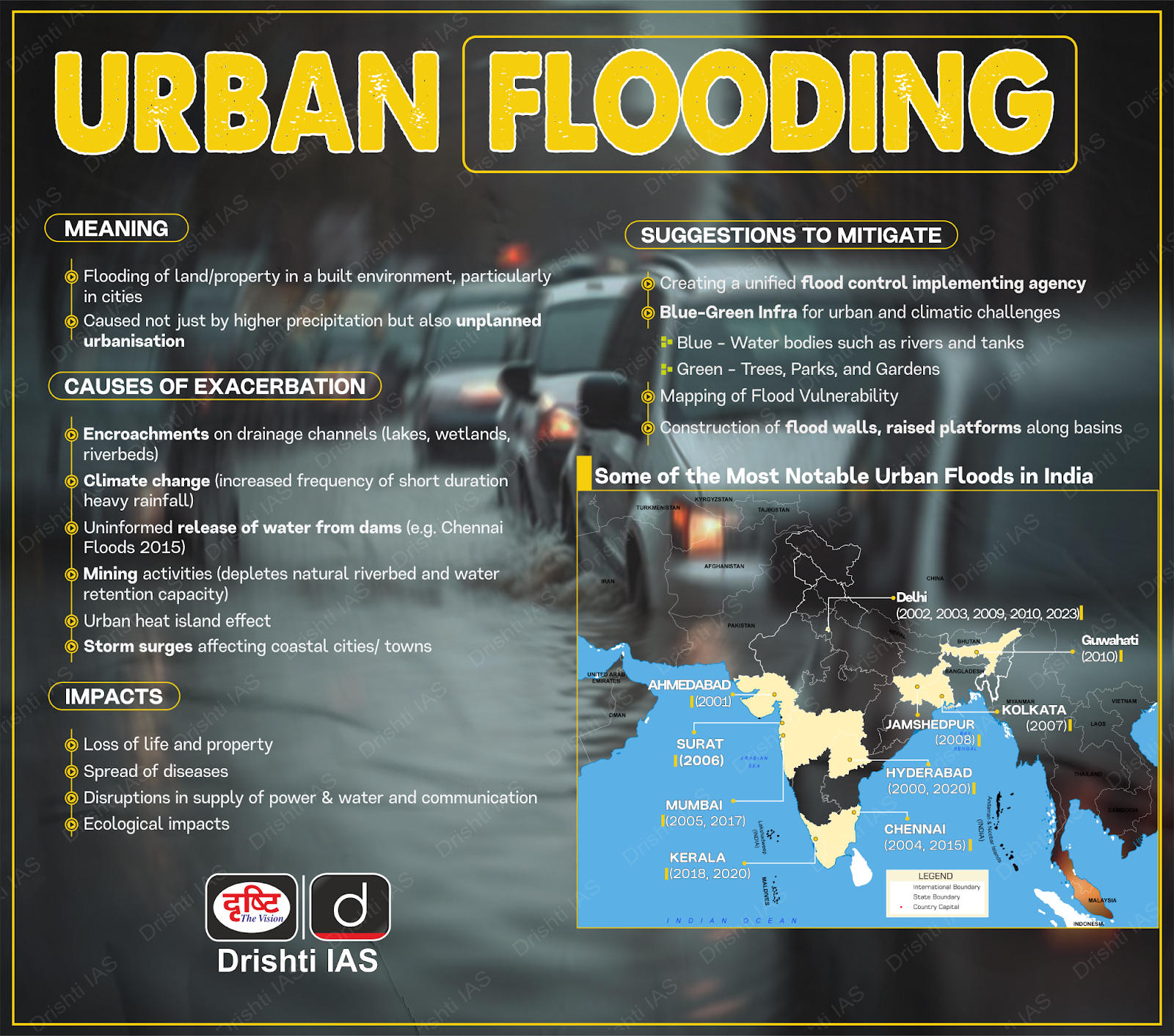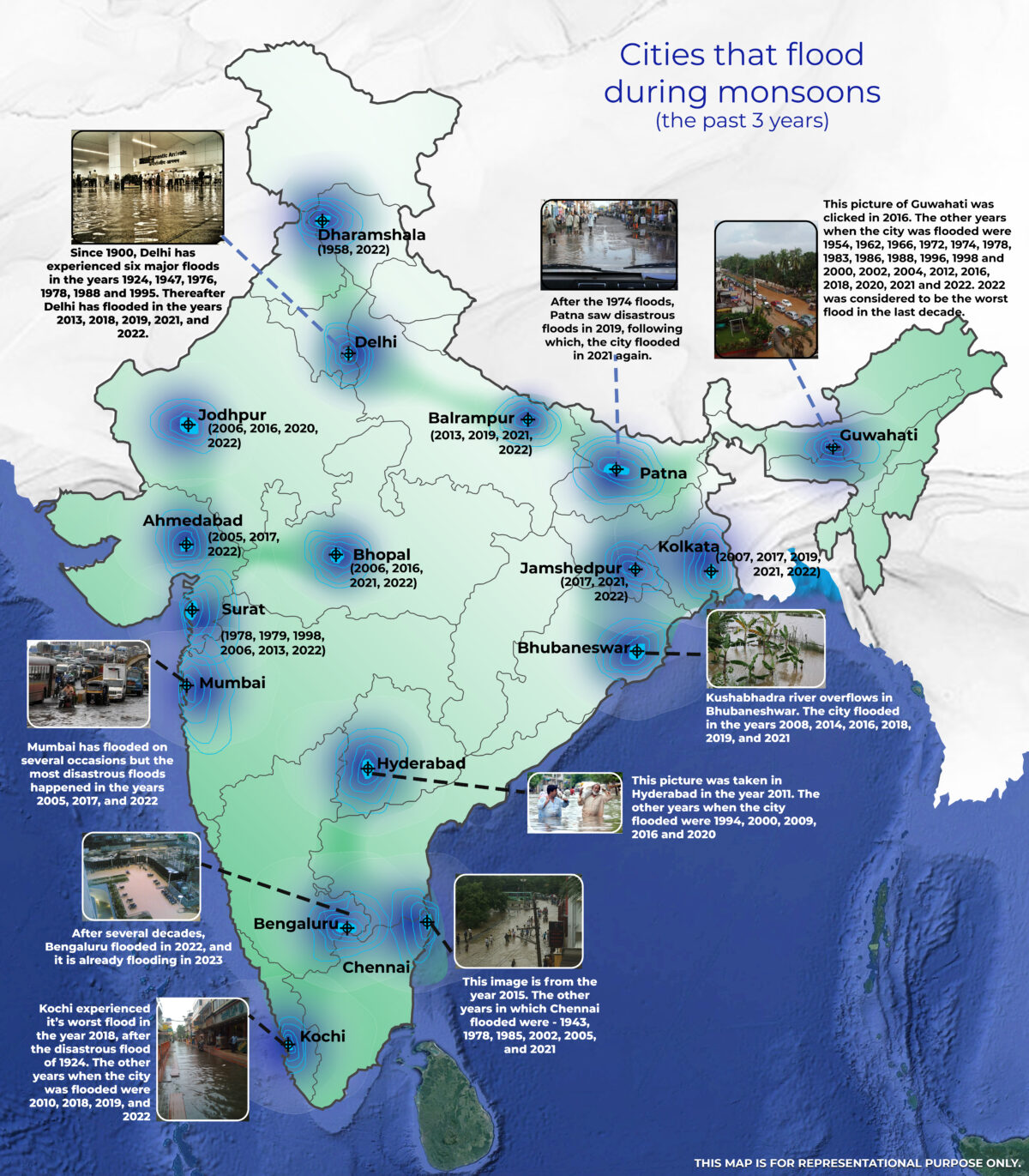Disaster Management
Urban Flooding in India
- 29 May 2025
- 10 min read
For Prelims: Urban flooding, Extreme weather events, Eco-sensitive zones, Climate change, Indian Meteorological Department, Flood Management in India
For Mains: Reasons for Increased Urban Flooding in India, Major Impacts of Urban Flooding.
Why in News?
Bengaluru experienced intense pre-monsoon rains leading to severe waterlogging, lake overflows, and significant damage to life and property. With the early onset of the monsoon this year, the risk of urban flooding in the city is expected to escalate further.
What is Urban Flooding?
- Urban flooding refers to the inundation of land or property in densely populated areas due to heavy rainfall, overflowing rivers, poor drainage systems, or other water-related incidents.
- It leads to waterlogging, disrupting transportation, damaging infrastructure, and posing health hazards to urban populations.
- Examples: Bengaluru floods (2024), Delhi Floods (2023), Mumbai floods (2020), Chennai floods (2015).
What are the Key Reasons for Urban Flooding in India?
- Natural Causes:
- Heavy Monsoon Rainfall: The Indian subcontinent experiences intense monsoon precipitation from Southwest Monsoon, especially in the Western Ghats and northeastern regions. Cities like Mumbai often receive heavy downpours in short durations, overwhelming drainage systems.
- Eg: The 2015 Chennai floods were triggered by record-breaking monsoon rains linked to cyclonic circulation over the Bay of Bengal.
- Topography: Many Indian cities are located in floodplains or low-lying coastal zones (e.g., Mumbai on the Konkan coast, Kolkata in the Ganga-Brahmaputra delta). These areas naturally accumulate runoff due to flat terrain and slow drainage, exacerbated by high tidal influence in coastal cities.
- Also, cities like Bengaluru, at an elevation of about 900 metres, lack major rivers to naturally channel excess water.
- Climate Change & Extreme Weather Events: Climate change has led to more frequent and intense rainfall, triggering flash floods.
- For example, the 2023 Delhi floods resulted from record rainfall causing the Yamuna River to overflow into urban areas.
- Heavy Monsoon Rainfall: The Indian subcontinent experiences intense monsoon precipitation from Southwest Monsoon, especially in the Western Ghats and northeastern regions. Cities like Mumbai often receive heavy downpours in short durations, overwhelming drainage systems.
- Anthropogenic Causes:
- Rapid Urbanization & Poor Planning: Unplanned urban growth has led to the concretization of natural drainage channels and encroachment on wetlands and floodplains.
- For instance, Bengaluru once had over 1,000 lakes, but around 80% have been lost or degraded due to encroachment and construction, reducing natural water retention and increasing runoff.
- Inadequate Drainage Infrastructure: Many Indian cities depend on outdated, undersized drainage systems that cannot manage intense rainfall.
- For instance, Mumbai’s British-era drainage, designed for 25 mm/hr, is frequently overwhelmed during heavy monsoons, as seen in the 2023 floods.
- Solid Waste Mismanagement: Unregulated dumping of solid waste blocks drains, nullahs, and stormwater systems, aggravating urban flooding.
- For instance, in Himachal Pradesh in 2023, plastic waste clogged both natural and artificial waterways, worsening the flood impact.
- Also, 2015 Chennai floods were worsened due to silt and waste blocking estuary canals, along with unchecked urban development that blocked natural water flow.
- Deforestation: Deforestation and improper land use caused by shifting cultivation (Jhum) and grazing in hill tracts increase surface runoff and silt buildup, leading to urban flooding downstream.
- For example, Assam’s Guwahati faces recurring floods due to such deforestation.
- Rapid Urbanization & Poor Planning: Unplanned urban growth has led to the concretization of natural drainage channels and encroachment on wetlands and floodplains.
What are the Major Impacts of Urban Flooding?
- Economic Loss and Infrastructure Damage: Urban flooding causes severe damage to critical infrastructure like roads, bridges, power, and water systems, leading to huge repair costs and economic disruption.
- Eg: 2015 Chennai floods resulted in damages exceeding Rs 15,000 crore, severely impacting transport and power supply.
- Public Health Crisis: Urban flooding leads to public health crises by creating stagnant water that breeds mosquitoes, increasing diseases like malaria and dengue. Contaminated drinking water also causes outbreaks of cholera, typhoid, and hepatitis.
- Eg: 2020 Kerala floods saw a rise in leptospirosis and other waterborne diseases.
- Displacement and Social Vulnerability: Urban flooding disproportionately impacts vulnerable groups, especially residents of informal settlements and low-lying areas. Thousands are displaced, losing homes and access to basic services, worsening poverty and inequality.
- The 2022 Mumbai floods led to slum dwellers facing severe displacement and livelihood loss.
- Ecological Degradation and Water Pollution: Urban floods carry pollutants, sewage, and industrial waste into lakes and rivers, harming aquatic ecosystems and reducing biodiversity. This contamination, seen in Bengaluru’s lakes, disrupts groundwater recharge and natural flood control.
- Also, rapid runoff causes soil erosion and damages green spaces, worsening urban water scarcity.
- Overburdened Infrastructure: Recurring urban floods expose failures in drainage, waste management, and city planning. Blocked drains, inadequate stormwater systems, and encroachment on water bodies worsen flooding.
- Mumbai’s outdated drainage, seen during the 2023 floods, often collapses, causing severe waterlogging and costly emergency responses.
What Measures Can be Adopted to Enhance Resilience Against Urban Floods?
- Integrated Watershed Management: Comprehensive management of entire river basins helps control flooding at the source by considering upstream and downstream impacts.
- For example, the Netherlands’ "Room for the River" project, which creates designated spaces for rivers to safely overflow, can be adapted to Indian urban contexts to reduce flood hazards.
- Promote Sustainable Urban Drainage Systems (SUDS): Integrate permeable pavements, rain gardens, bio-swales, and detention basins to manage runoff at source and reduce pressure on drainage. This mimics natural hydrological processes and enhances infiltration.
- Adopt the Sponge City Concept: The Sponge City approach involves designing urban landscapes that absorb, store, and purify rainwater through natural and engineered solutions, reducing runoff and flood peaks.
- Shanghai, China has adopted green roofs, permeable surfaces, and green spaces under this model.
- Similarly, Mumbai's is also adopting this model to enhance flood resilience and groundwater recharge.
- Restoration of Water Bodies: Reviving urban lakes, wetlands, and natural water retention zones enhances flood absorption capacity.
- Bengaluru’s Jakkur Lake restoration showcases effective flood mitigation through eco-restoration.
- Community Engagement & Early Warning Systems: Active involvement of local communities in flood preparedness and response strengthens resilience.
- Establishing robust early warning systems, similar to Ahmedabad’s heat action plan which includes community outreach, can be adapted to improve urban flood management.
- Singapore's Smart Water Assessment Network (SWAN) uses remote sensors to track water levels in real time, issuing alerts via SMS to ensure quick public response and flood preparedness. India can learn from the same.
Conclusion
Urban flooding in India, driven by unplanned urban growth and climate change, poses a serious threat to life, property, and infrastructure. A resilient approach demands integration of sponge city principles, smart stormwater management, restoration of wetlands, and climate-responsive urban planning. Active community engagement and institutional coordination are essential for long-term flood mitigation and sustainable urban development.
|
Drishti Mains Question: Discuss the key factors contributing to urban flooding and suggest measures for effective flood management. |
UPSC Civil Services Examination, Previous Years Questions (PYQs)
Mains:
Q. The interlinking of rivers can provide viable solutions to the multi-dimensional inter-related problems of droughts, floods, and interrupted navigation. Critically examine. (2020)
Q. Account for the huge flooding of million cities in India including the smart ones like Hyderabad and Pune. Suggest lasting remedial measures. (2020)








